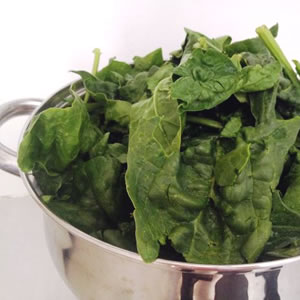While children in the classroom are learning about the contributions of African-Americans during Black History Month, there are also lessons to be learned in the kitchen.
Cooked greens were found on African-American - and Southern - tables long before they appeared on the menus of fashionable restaurants. Edna Lewis, the grand dame of African-American cooking and a national spokesperson for Southern cooking, remembers growing up in rural Virginia and picking wild greens not only for food, but for medicine. "If you were sick," she writes, "your neighbor might walk a mile or more to pick something green to bring to your bedside, and then sit by the bed to feed and comfort you. Those greens were like black folks' health food."
Greens are low in calories and fat. They are also rich in fiber and vitamins A and C. Greens also contain naturally-occurring substances called phytochemicals that help fight cancer. A single serving of leafy greens is estimated to contain more than 100 different phytochemicals.
The most common greens are collard, kale, chard and broccoli rabe. They all look quite different. Collard greens have large, cabbage-like leaves and are a muted green, sometimes tinged with blue. Most varieties of kale have ragged or frilled leaves ranging in color from bluish to almost black, magenta, yellow, or gray. Chard usually has dark green leaves that are usually ruffled. The leafy green broccoli rabe (also called rape or rapini) has 6- to 9-inch stalks and clusters of small buds that look like broccoli.
When you buy greens, look for those that are crisp and unblemished. The darker the color, the higher the nutritional value. Leafy greens are highly perishable and should be used within a few days of purchase. If you are not going to cook them immediately, wrap them, unwashed, in damp paper towels and refrigerate in a plastic bag with a few air holes so the greens can breathe.
Content Continues Below ⤵ ↷
Greens can be full of soil and grit, so wash them carefully before cooking. They should not be cooked in pans made of aluminum, which gives them an unpleasant taste. Keep in mind that greens cook way down. A pound of fresh greens will result in 1-1/2 to 2 cups of cooked greens, or about 4 servings.
After you try this recipe, you may agree with Edna Lewis that, "Greens are a dish that most Southerners would walk a mile for."
GARLICKY GREENS
Makes 4 servings.
Ingredients
- 1 Tbsp. extra-virgin olive oil
- 3/4 cup sliced leek, white part only
- 1/2 cup chopped scallions (about 3), both green and white parts
- 1 Tbsp. minced garlic (2 large cloves)
- 3 cups chopped kale
- 1 cup chopped broccoli rabe
- 3 cups collard greens cut in 1/2-inch ribbons
- 5 cups fresh spinach
- 1 cup fat-free, reduced-sodium chicken broth
- Salt and freshly ground black pepper, to taste
Directions
- Heat oil in a large, heavy skillet over medium-high heat. Add leek, scallions and garlic. Saut� until leeks are limp, about 4 minutes.
- Add kale, broccoli rabe and collards, stirring until wilted. Mix in spinach. Add broth and simmer, stirring occasionally, until greens are tender, about 15 minutes. Season to taste with salt and pepper.
Per serving:
101 calories
4 g. total fat (less than 1 g. saturated fat)
14 g. carbohydrate
5 g. protein
4 g. dietary fiber
214 mg. sodium
AICR
